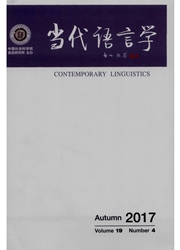

 中文摘要:
中文摘要:
本文旨在探讨惯常范畴的语义类型和标记方式,聚焦于汉语表达惯常义的特点。我们首先分出惯常义的四种类型,然后简析汉语方言的几个惯常标记(南方方言的助动词“要、会、有”、句末助词“的”及北方方言的句末助词“呢、着”),以此为基础探讨了惯常义的标记度及汉语惯常标记的类型,并构建了惯常范畴的语义地图,从而整理出时体态三大范畴的交接状况。这种惯常标记的跨方言比较不仅推进了对特定语法词的认识,亦窥见到南北汉语在语序结构及时体态范畴上的类型差异。本研究仅是该课题的初步探索,有待更多方言/语言来验证和改进。
 英文摘要:
英文摘要:
This paper investigates the habitual-generic category based on the data from a variety of Chinese dialects. First, it outlines a semantic classification of habitual-generic meanings, which contains the following notions: 1. High Frequency: He often goes swimming, 2. Circumstantial Necessity: The river in the north will freeze in winter. 3. Habitual Nature: The Japanese eat raw fish. 4. Stative Property: John is smart. These habitual-generic notions differ in dynamicity, and can form a dynamicity hierarchy" circumstantial necessity ≥ high frequency 〉 habitual nature 〉 stative property. In this hierarchy, the notion on the left can accommodate more types of telic predicate than those on the right. Second, this study presents a comprehensive description on the habitual-generic markers of Chinese dialects. Six types of habitual-generic markers have been identified in Chinese according to their related functions, which are listed below: l. The irrealis zero-form: almost each dialect can use zero grammatical marker in certain habitual-genetic expressions, as it does in irrealis expressions. 2. The future marker: Southern Chinese often uses future modals, like yao (要) ' want, will', to express habitual-generic meanings. 3. The ability marker: Wu, Min and Yue dialects use ability modals, like hui (会) ' can', to express habitual-generic meanings. 4. The realis-existential modal: Min and Yue dialects use the realis-existential modal you (有) ' have' to express a variety of habitual-generic meanings. 5. The realis-focusing marker: Wu and Yue dialects often require the presence of the realis-focnsing marker de (的) (which is also the nominalization marker) in habitualgeneric expressions. 6. The durative marker: a variety of dialects employ the durative marker in habitualgeneric expressions. Third, the differences of habitual-generic markers between Southern Chinese and Northern Chinese are identified and accounted for. It is found that Southern
 同期刊论文项目
同期刊论文项目
 同项目期刊论文
同项目期刊论文
 期刊信息
期刊信息
